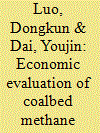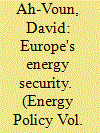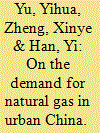|
|
|
Sort Order |
|
|
|
Items / Page
|
|
|
|
|
|
|
| Srl | Item |
| 1 |
ID:
091545


|
|
|
|
|
| Publication |
2009.
|
| Summary/Abstract |
Roaring natural gas demand, energy security and environment protection concerns coupled with stringent emission reduction requirement have made China's abundant coalbed methane (CBM) resource an increasingly valuable energy source. However, not all of China's CBM resource is economic to develop under current technological condition and economic situation. In order to locate the CBM resource with economic viability to develop in China, economic evaluation of CBM production is conducted by applying net present value (NPV) method. The results indicate that more than half of CBM resource in China is economic to develop. It shows that CBM price, production rate and operating costs are the three major factors with most impact on the economic viability of the CBM development in target areas in China. The result also demonstrates that the economic limit production is roughly 1200 cubic meters per day. These economic evaluation results provide important information for both CBM companies and China government.
|
|
|
|
|
|
|
|
|
|
|
|
|
|
|
|
| 2 |
ID:
192713


|
|
|
|
|
| Summary/Abstract |
This paper examines the impact of EU energy policies, namely the National Energy and Climate Plans (NECP19) and REPowerEU (2022), on the European natural gas security of supply. Our analysis shows that the REPowerEU plan significantly cuts gas demand by 133 bcm compared to NECP19. This shift can make Europe independent from Russian gas by 2030. Executing REPowerEU requires faster, clean technology deployment. The EU needs to catch up in installations to reach REPowerEU targets, while NECP19 maintains high gas demand (423 bcm till 2030), potentially exacerbating gas import dependence. NECP19 not only raises gas demand but also brings substantial inter-annual variation (IAV) of demand. In cold years (twice in ten years), demand spikes by 39 bcm, and warm years (three in ten years) decrease it by 23 bcm. REPowerEU, while moderately increasing gas demand variation (around 7% versus NECP19), does not solve the demand variability issue. In extremely cold years (one in forty years), Europe may face a 46 bcm gap, around a quarter of the spot LNG market. Failing REPowerEU not only heightens gas import risk but also risks price spikes under varying climates and global market conditions. We offer policy recommendations to address potential price spikes related to IAV demand.
|
|
|
|
|
|
|
|
|
|
|
|
|
|
|
|
| 3 |
ID:
132747


|
|
|
|
|
| Publication |
2014.
|
| Summary/Abstract |
Using a set of unbalanced panel data for Chinese×s cities during the period of 2006-2009, this study aims to estimate the price and income elasticities of residential demand for natural gas. Natural gas consumption is specified as a function of its own price; substitute prices; urban wages; and other supply, climate, and housing characteristics. Using a feasible generalised least squares (FGLS) technique, which controls for panel heteroskedasticity and panel correlation, we find that natural gas consumption is price elastic and income inelastic when other covariates (e.g., the supply of natural gas pipeline and heating degree days) are controlled. In addition, there are large variations in demand behaviours across China×s regions. There is a substantial income effect on demand for natural gas in southern China, whereas the northern regions are found to have a higher price effect. In addition, the substitution effect between coal and natural gas is significant in North China but is not significant in South China. These findings have several important policy implications for natural gas pricing and supply cost analysis in the context of China.
|
|
|
|
|
|
|
|
|
|
|
|
|
|
|
|
|
|
|
|
|